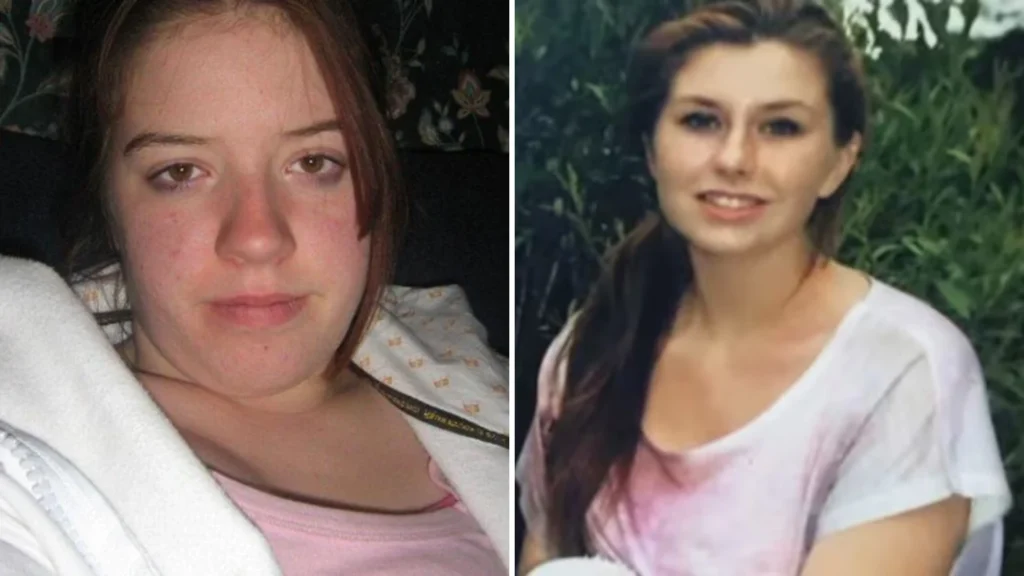On December 28, 2017, plumbers were called to a duplex on McMillan Drive in Oshawa, Ontario, after tenants complained of a persistent drain blockage. The man living in the basement unit, Adam Strong, told them the problem was caused by an inflated condom.
When the plumbers fed their mechanical snake into the pipe, it caught on something unusual. They pulled out roughly 10 to 15 pounds of soft, flesh-like material. Unsure what they had found, they contacted police.
Officers arrived at the scene. When they knocked on Strong’s door, he opened it and said, “The jig’s up. It’s a body.”
Inside his apartment, investigators found a strong odor and a cluttered living space. In the freezer, they discovered human remains, including a head with a tattoo reading “Alive.”
DNA tests later confirmed the remains belonged to 18-year-old Rori Hache, who had been missing since August 2017. What began as a routine plumbing job had uncovered a homicide one that would lead investigators to a second missing woman and reveal the actions of a serial killer operating unnoticed for years.

The Missing Teen
Rori Hache was last seen alive on August 29, 2017, leaving Lakeridge Health Hospital in Oshawa. Security footage showed her walking out alone after sitting briefly in the waiting room. She never spoke to a doctor.
Born in July 1999, Rori grew up in Oshawa, a city east of Toronto. As a child, she was bright, energetic, and served as an Army Cadet, twice earning the Cadet of the Year award by age 13.
Her teenage years were turbulent. At 14, she was introduced to crystal meth, beginning a years-long struggle with addiction. Her family background was complicated her grandfather, Bernie Guindon, founded the Satan’s Choice Motorcycle Club, once Canada’s second-largest biker gang. Despite that, her relatives described Rori as gentle and compassionate, especially toward the elderly and animals.
By mid-2017, she was rebuilding her life. She had a steady boyfriend, Tony, and had returned to school. That summer, a pregnancy test confirmed she was expecting a child. Friends said she seemed hopeful and determined to change.
But weeks later, a fire broke out at her mother’s home, injuring her mother and killing their dog. Rori’s family believed the event deeply unsettled her. Soon after, she began showing signs of stress and secrecy.
On August 29, she went to the hospital with a friend and the friend’s mother, possibly experiencing a mental episode. They left her there, expecting she’d be seen by doctors. Fifteen minutes later, she walked out and vanished.
For nearly two weeks, her family searched the streets, posted flyers, and contacted local shelters. Then, on September 11, 2017, a fisherman and his 11-year-old grandson spotted something floating in Oshawa Harbor.
What they reeled in was not debris — it was a female torso.

Identification
The torso pulled from Oshawa Harbor on September 11, 2017, showed clear signs of trauma. The limbs and pelvis had been cleanly severed, suggesting deliberate dismemberment. Police could not determine whether the victim had been pregnant, and without fingerprints or dental records, identification was difficult.
Investigators sent DNA samples for testing, comparing them with those from several open missing person cases in the region. Weeks passed without progress.
Then, on November 10, 2017, lab results confirmed a match the remains belonged to Rori Hache, missing since late August. Her disappearance was now officially classified as a homicide.
The discovery stunned Oshawa. Rori had been well-known in the city’s youth outreach programs, particularly at The Refuge, a local center for at-risk teens. Workers there said she had been doing better shortly before she vanished. The idea that her body had been mutilated and discarded in the harbor left the community reeling.
Despite extensive searches around the waterfront and nearby properties, no further remains were found. Detectives had no suspects and no clear timeline of Rori’s final movements after she left the hospital. The investigation stalled until three months later, when plumbers opened a blocked pipe just a few blocks away.

The Man in the Basement
When police entered Adam Strong’s basement apartment on McMillan Drive, they found a scene that pointed to something far darker than a single killing. The space was cramped, cluttered, and filled with a strong odor of decay. Alongside food wrappers and tools, officers discovered restraints, adult paraphernalia, knives, and a hammer.
On the hammer, forensic testing later found Rori Hache’s DNA. Blood spatter lined the baseboards near Strong’s bedroom. In a plastic bag, police recovered Rori’s running shoes, marked with what appeared to be blood.
As officers processed the scene, Strong spoke freely. He told them, “If you want the rest of her, she’s in my freezer.” He admitted to dismembering Rori’s body on Christmas Eve 2017, claiming he waited until neighbors were away to avoid attention. He said she had been “defleshed,” describing the process in clinical, detached terms.
An autopsy confirmed multiple facial fractures and blunt-force injuries, but the cause of death could not be determined. Traces of drugs were found in her system, though not enough to explain her death.
Investigators seized Strong’s computer. His search history revealed a fixation on gore, death, and bondage. They also found an undetonated pipe bomb, forcing a controlled detonation by the bomb squad outside the building.
But the most significant discovery was a specialized hunting knife found in his kitchen drawer. When tested, it carried DNA from another woman, one who had vanished nearly a decade earlier.

A Second Victim
The DNA on the knife belonged to Kandis Fitzpatrick, a 19-year-old who had disappeared from Oshawa in 2008. Her family had last seen her nearly ten years earlier and reported her missing in 2010, after years without contact.
Like Rori, Kandis had struggled with addiction and homelessness but remained close to her family. Her father described her as strong-willed and street-smart not someone easily overpowered. When police informed him her DNA had been found on Strong’s knife, he said he had always believed his daughter was the victim of someone experienced in violence.
Investigators searched Strong’s apartment again but found no trace of Kandis’s remains. Still, her DNA evidence was enough for prosecutors to charge Strong with her manslaughter alongside the first-degree murder of Rori Hache.
Strong never confessed to killing either woman. He claimed Rori died accidentally and that he panicked, dismembering her body to avoid blame. For Kandis, he said only that he “knew her,” offering no explanation for her DNA on his knife.
Detectives believed the two women met similar fates both young, vulnerable, and known around Oshawa’s downtown streets. The gap of nearly a decade between their disappearances raised a disturbing question: had Strong killed others in the years between?
By November 2018, Adam Strong was formally charged with both crimes. His apartment, once a quiet basement rental, had become one of the most horrific crime scenes in Ontario’s recent history.

Trial and Conviction
Adam Strong’s trial began in 2020, delayed several times by the COVID-19 pandemic and his own refusal to cooperate. Much of the testimony was heard over video link. Prosecutors portrayed him as a sexual predator who targeted vulnerable young women, drawing on his fascination with violent pornography and control.
Two former girlfriends testified that Strong practiced bondage and choking during sex one said it was consensual, the other said she feared for her life. The Crown used these accounts to show a pattern of escalating aggression.
Strong maintained he hadn’t killed Rori or Kandis, only dismembered Rori after finding her dead in his home. He said her body had been there for days before he decided to dispose of it. But forensic evidence contradicted him: blood was found throughout his apartment, and Rori’s injuries were consistent with a violent assault.
Despite his attempts to stall proceedings often refusing to attend hearings or meet his lawyer the court pressed on. On March 16, 2021, a Durham Regional jury convicted Adam Strong of first-degree murder in the death of Rori Hache and manslaughter in the death of Kandis Fitzpatrick.
He was sentenced to life in prison with no parole eligibility for 25 years. For the Fitzpatrick case, he received a concurrent 18-year term.
Even in custody, Strong showed no remorse. But months later, in July 2021, he told a prison guard where to find Kandis’s remains buried at an intersection in Oshawa. Police recovered them, finally giving her family the closure they’d waited more than a decade for.

Aftermath
With both victims identified and Adam Strong imprisoned, the investigation closed, but the shock lingered in Oshawa. Detectives later said the case revealed how a killer had hidden in plain sight for years renting the same basement unit, working part-time jobs, and moving unnoticed among the city’s most vulnerable.
Rori Hache’s family struggled with the loss. Her grandfather, Bernie Guindon, once the founder of Satan’s Choice Motorcycle Club, was said to be enraged. Within Canada’s biker circles, word spread quickly: Strong had killed a biker’s granddaughter. Even fellow inmates acknowledged the risk. “You can’t kill a biker’s granddaughter and get away with it,” one convict told reporters.
Kandis Fitzpatrick’s family, who had lived with uncertainty for over ten years, finally had answers but little comfort. Her father described the verdict as “a weight lifted,” though the recovery of her remains reopened old wounds.
Residents of Oshawa said the case shattered their sense of safety. The home on McMillan Drive, located less than two kilometers from the downtown core and police headquarters, stood as a reminder of what had gone unnoticed.
Strong has never explained how he met either woman, nor has he revealed whether more victims exist between 2008 and 2017 a nine-year silence that continues to haunt investigators.
The drain blockage that winter day exposed more than a crime scene; it revealed the quiet persistence of evil hidden behind an ordinary door.

Legacy of the Case
The murders of Rori Hache and Kandis Fitzpatrick reshaped how local police handled missing persons in Durham Region. Both women were initially dismissed as “runaways,” a label that delayed investigation for weeks and, in Kandis’s case, years. After Strong’s conviction, the Durham Regional Police Service reviewed its missing persons protocols, emphasizing faster responses and improved coordination with families.
Forensic teams also cited the case as a turning point. Without the plumber’s discovery in December 2017, Strong might never have been caught; advances in DNA tracing and forensic genealogy had turned what began as a plumbing complaint into a double-homicide conviction.
In 2022, Rori’s mother, Shanan Dionne, began speaking publicly about her daughter’s life not just her death. She described Rori as “fearless, stubborn, and full of fire,” a young woman whose story should serve as a warning about how quickly vulnerable people can disappear unnoticed.
Kandis’s name, too, gained renewed attention. Advocates used her case to highlight the risks faced by transient youth and the need for social systems that don’t let them vanish into silence.
Today, the McMillan Drive basement where Adam Strong lived has been sealed off and resold, but few in Oshawa forget what was found there. Beneath the floorboards, a city learned how close horror can live to home and how easily it can be ignored.

The Unanswered Questions
Even after conviction, key mysteries remain. Police never determined exactly how Rori Hache died. Her body was too badly dismembered for a definitive cause of death, though evidence of blunt-force trauma and blood spatter patterns suggested violence before death.
In Kandis Fitzpatrick’s case, investigators could only confirm she’d been killed not when, where, or how. The decade-long gap between her disappearance and the discovery of her DNA raised grim possibilities. Detectives quietly reexamined other missing women from Oshawa and nearby towns, searching for any trace linking back to Strong.
No further evidence has surfaced, but the timeline leaves questions. What happened between 2008 and 2017? Did Strong kill others, or did he simply stop? His silence has left investigators divided some believe he was a serial offender who grew cautious; others think his crimes began and ended with the two women he believed he could control.
Strong, now in his mid-40s, remains at Millhaven Institution, serving a life sentence. He has never spoken publicly since his conviction, never apologized, and never explained why.
For many in Oshawa, that silence is the final cruelty. The city remembers two women both young, both overlooked whose stories only came to light because of a clogged basement drain.

